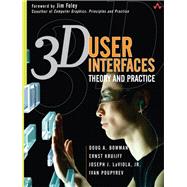Here’s what three pioneers in computer graphics and human-computer interaction have to say about this book:
“What a tour de force—everything one would want—comprehensive, encyclopedic, and authoritative.”
—Jim Foley
“At last, a book on this important, emerging area. It will be an indispensable reference for the practitioner, researcher, and student interested in 3D user interfaces.”
—Andy van Dam
“Finally, the book we need to bridge the dream of 3D graphics with the user-centered reality of interface design. A thoughtful and practical guide for researchers and product developers. Thorough review, great examples.”
—Ben Shneiderman
As 3D technology becomes available for a wide range of applications, its successful deployment will require well-designed user interfaces (UIs). Specifically, software and hardware developers will need to understand the interaction principles and techniques peculiar to a 3D environment. This understanding, of course, builds on usability experience with 2D UIs. But it also involves new and unique challenges and opportunities. Discussing all relevant aspects of interaction, enhanced by instructive examples and guidelines, 3D User Interfaces comprises a single source for the latest theory and practice of 3D UIs.
Many people already have seen 3D UIs in computer-aided design, radiation therapy, surgical simulation, data visualization, and virtual-reality entertainment. The next generation of computer games, mobile devices, and desktop applications also will feature 3D interaction. The authors of this book, each at the forefront of research and development in the young and dynamic field of 3D UIs, show how to produce usable 3D applications that deliver on their enormous promise.
Coverage includes:
- The psychology and human factors of various 3D interaction tasks
- Different approaches for evaluating 3D UIs
- Results from empirical studies of 3D interaction techniques
- Principles for choosing appropriate input and output devices for 3D systems
- Details and tips on implementing common 3D interaction techniques
- Guidelines for selecting the most effective interaction techniques for common 3D tasks
- Case studies of 3D UIs in real-world applications
To help you keep pace with this fast-evolving field, the book’s Web site, www.3dui.org, will offer information and links to the latest 3D UI research and applications.









